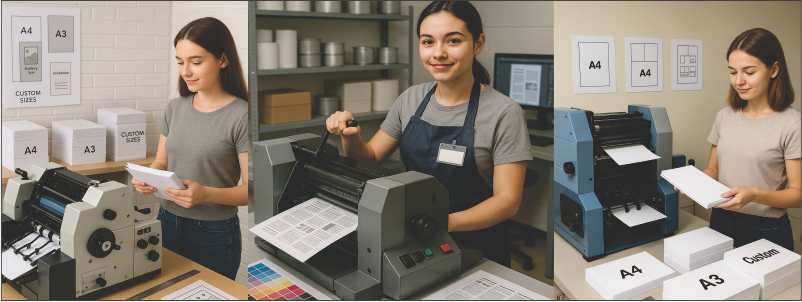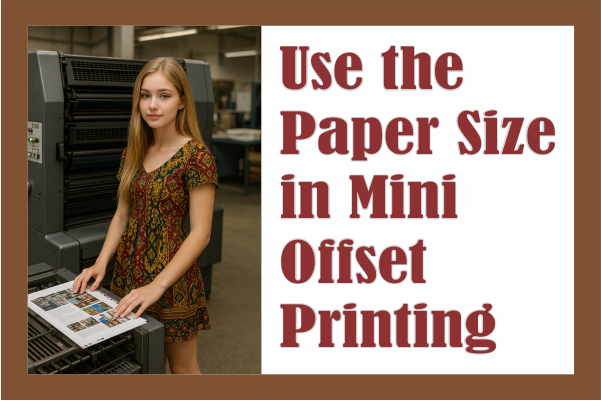In the world of printing, especially in paper size in Mini Offset Printing, choosing the correct paper size is more than a matter of convenience—it is a critical decision that affects cost, efficiency, and final output quality. Unlike digital printing, where the machine automatically adjusts to a range of paper sizes, mini offset presses require manual or semi-automated setup that is tightly linked to the dimensions of the paper being used.
This blog explores how paper sizes in mini offset printing influence the performance of mini offset printing, which paper sizes are best for which jobs, and how to maximize quality and minimize waste.
Understanding paper size in Mini Offset Printing
Paper size in Mini Offset Printing is a scaled-down version of traditional offset printing. It is ideal for small businesses, educational institutions, and local printing units due to its affordability, compact size, and relatively simple operation.
Key features include:
- Single or dual-color printing
- Smaller plate and blanket sizes
- Manual or semi-auto paper feeding
- Commonly used for short-run jobs like letterheads, bill books, and flyers
Mini offset presses usually support limited paper size in mini offset printing ranges, which makes knowledge of standard and compatible paper dimensions vital for successful printing.
Importance of Paper Size in mini offset Printing
Paper size in mini offset printing directly impacts:
- Print layout and imposition
- Machine compatibility and feeding
- Print quality and registration
- Ink consumption
- Cutting and binding process
- Final product cost and profitability
In short, selecting the right size not only enhances quality but also improves production efficiency.
Common Paper Sizes in Mini Offset Printing Used
A-Series Paper Sizes (ISO 216 Standard)
The most commonly used paper size in mini offset printing are based on the A-series, which are standardized globally.
| Size | Dimensions (mm) | Common Uses |
| A4 | 210 × 297 | Letterheads, invoices, forms |
| A3 | 297 × 420 | Brochures, posters, booklets |
| A5 | 148 × 210 | Notepads, flyers, coupons |
| A6 | 105 × 148 | Postcards, invitation cards |
Legal and Letter Sizes (US Standard)
Some printers, especially in North America or global institutions, use these formats:
• The dimensions of a normal letter-sized sheet is 216 × 279 mm (8.5 × 11 inches).
• Size in legal terms: 216 × 356 mm (8.5 × 14 inches)
These are less common in India and most parts of Asia but may still be required for specific jobs.
Custom Sizes
Custom sizes are often used for:
- Business cards
- Custom labels
- Packaging inserts
- Envelopes
Custom sizing requires trimming post-print and precise imposition planning.
Choosing the Right Paper Size in mini offset printing for Different Print Jobs
| Job Type | Recommended Paper Size | Notes |
| Letterheads | A4 | Standard office communication size |
| Flyers | A5 or A4 | A5 is cost-effective for bulk runs |
| Envelopes | DL, C5, or custom | Must match enclosure sizes |
| Bill Books | A5 or Legal | Legal useful for columns & spacing |
| Posters | A3 | Bigger impact, suitable for display |
| Event Tickets | A6 or Custom | Easy to handle and distribute |
Always consider the final application and client requirements before selecting a paper size.
Machine Compatibility and Paper Feeding Mechanism
paper size in mini offset printing machines typically support sizes up to A3 or slightly beyond. Paper feeding methods include:
- Manual Feed Trays: Ideal for short runs and odd sizes
- Semi-Automatic Feeders: Faster, more accurate
- Single Sheet vs. Stack Feeders: Based on machine configuration
Key Considerations:
- Ensure correct alignment to prevent misregistration
- Avoid oversize sheets that require excessive trimming
- Check maximum and minimum size support from machine manual
Impact of Paper Size in mini offset printing on Cost and Efficiency
Larger sheets:
- Require more ink
- Consume more power
- May need additional cutting
Smaller sheets:
- Offer higher yield from parent sheets
- Are easier to handle
- Are faster to print
Example: If printing A6 flyers from an A3 sheet, you can fit 4 per side, reducing cost per unit.
Layout Planning and Imposition Techniques
Imposition refers to how pages or designs are arranged on a sheet to minimize waste.
Common techniques include:
- Layout Options: Depending on the size of the sheet, it can be set up in 2-up, 4-up, or 8-up forms.
- Tight margin planning to reduce trimming waste
- Booklet printing: Proper page ordering and folding logic
Correct imposition allows multiple copies per sheet, reducing time and material costs.
Paper Grain Direction and Its Importance
Paper grain affects:
- Folding
- Curling
- Registration accuracy
- Binding
Always print with the grain parallel to the machine feeding direction, especially for:
- Booklets
- Folded brochures
- Multicolor jobs
Improper grain alignment leads to:
- Tearing
- Misfolds
- Ink smudging
Paper Types and Thickness (GSM) Considerations
Common GSM (grams per square meter) options paper sizes in mini offset printing :
| GSM Range | Use Case |
| 70–80 GSM | Letterheads, forms, bills |
| 100–130 GSM | Flyers, brochures |
| 170–220 GSM | Certificates, small posters |
| 250+ GSM | Cards, covers, thick materials |
Thicker papers may require feed adjustment and pressure calibration.
Challenges with Incorrect Paper Sizes
Using the wrong paper size can cause:
- Jamming in the feed system
- Off-registration prints
- Extra trimming work
- Ink misalignment
- Customer dissatisfaction
Best Practice: Always measure and test sample sheets before full production.
Tips for Optimizing Paper Usage in Mini Offset
- Use standard sizes where possible
- Gang run multiple jobs on one sheet
- Reuse off-cuts for smaller jobs
- Adjust design margins for tight impositions
- Store paper in dry, flat stacks to avoid warping
Industry Standards and Recommendations
Most printers follow ISO 216 paper size guidelines. Ensure your press supports:
- Minimum size: A6 (105 × 148 mm)
- Maximum Printable Area: Up to A3+ size (around 320 × 460 mm)
Also, use:
- FSC-certified papers for eco-conscious clients
- Acid-free papers for archival printing

Case Studies and Real-World Applications
Case 1: Educational Institution Printing
- Job: Question papers
- Paper: A4, 70 GSM
- Setup: Imposed 2 pages per sheet
- Outcome: Reduced waste and delivery time
Case 2: Local Business Flyers
- Job: 2,000 promotional flyers
- Paper: A5, 100 GSM
- Setup: Printed 2 A5 flyers per A4 sheet
- Outcome: Saved 35% on paper cost
Future Trends: Automation and Digital Integration
Modern mini offset machines are now:
- Supporting digital imposition software
- Featuring auto-feeding and alignment systems
- Integrating with CIP3/4 systems for prepress planning
As machines become smarter, they will automatically suggest the best paper layout, size, and feed configurations for optimal results.
Conclusion
Understanding and using the right paper size in mini offset printing is crucial for achieving quality, cost-effectiveness, and operational efficiency. Whether you’re printing bill books, flyers, or educational materials, the correct selection of paper size ensures smooth production and professional results.
By mastering paper dimensions, layout techniques, and machine compatibility, even small-scale printers can deliver big-time quality and performance. So next time you load your mini offset press, remember: the right paper size is the first step to a perfect print.

